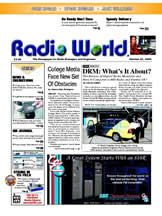| Part of
a Radio World series in
which we share
industry opinions about AM
revitalization.
Normally I offer tech
tips but this time I want to
express a personal opinion
on a topic important to me.
If it is a goal of the
Federal Communications
Commission to reduce
regulatory and financial
burden on AM broadcasters,
then here is one way to
help: Modify FCC rule
73.1590(a)(6) requiring
annual occupied bandwidth
and RF harmonic radiation
measurements on AM stations,
known as AM NRSC
measurements.
You might remember that
NRSC is the National Radio
Systems Committee, which
created standards for
occupied bandwidth on AM and
FM stations. The FCC turned
those standards into rules.
I propose to exempt AM
stations that use
solid-state transmitters
from the existing
requirement to make annual
measurements.
The rules were written
when vacuum tubes were often
used in transmitter designs.
Tube performance degrades
with time. The result is
that tubes must be replaced
every year or two in order
to maintain operating
specifications. Beyond that
time in service, an AM
transmitter may not be able
to comply with FCC rules for
occupied bandwidth, which
results in interference to
other stations on the dial.
In the case of FM
transmitters, a weak/soft
tube does not normally cause
bandwidth issues.
For AM stations
continuing to use tube
transmitters, this annual
requirement should still
apply. The requirement that
all AM and FM licensees keep
their equipment in
compliance with FCC rules
should stay in place,
regardless of which
transmitter design they use.
Changes in any AM or FM
equipment that could alter
the occupied bandwidth
should automatically trigger
the requirement to do
measurements to assure
compliance with FCC rules. A
30-day window to make
successful compliance
measurements sounds
appropriate to me. The
equipment change could be as
simple as replacing an audio
processor with a different
model number.
This rule revision would
bring AM stations into the
same level of scrutiny that
FM stations should meet; I
feel my suggested changes
will also assure FM
compliance.
SPECTRAL ANALYSIS
Note that any change in
equipment lineup could
unwittingly cause bandwidth
problems. The only way to be
sure the station is FCC
legal is to do spectral
analysis.
Further, the procedure
for AM and FM stations
should be written to require
listing model numbers of
studio transmitter links,
audio processors and
transmitters. (Serial
numbers are not important.)
In the case of FM stations,
audio processors, stereo
generators, RDS/RBDS
generators, studio
transmitter links and
transmitters should be
listed.
In essence, anything
capable of controlling or
changing occupied bandwidth
should be documented.
The report would not be
placed in a public file.
Instead it would go into the
station�s engineering file,
which is not seen by the
public. No change there. In
that way, a station�s
�custom lineup� of audio
processing would not be
revealed to competitors.
FCC FM rule 73.1590(d)
regarding measurement data
needs to be modified to
strike the words �for a
period of 2 years, and on
request must be made
available during that time
to duly authorized
representatives of the FCC.�
This re-written rule would
require measurement data to
be kept on hand until
superseded by a newer
report. It is documented
proof of legal operation.
An FCC inspector or mock
inspector would request this
report when visiting a
station. He or she would
check to see if the same
equipment is employed, even
if it is years later. Any
report that did not have
this data would be invalid.
Practically speaking, my
proposal would mean that all
or most stations would need
to perform a new set of
measurements based on these
criteria in the immediate
future. Again, any changes
in the equipment lineup
should require a
new set of measurements to
assure FCC compliance.
VIGILANCE
On another note, station
technical consultants need
to be vigilant in watching
for new transmitter sites or
changes to existing
transmitter sites within
five miles or so of the
transmitters they are
watching after. A new onsite
or offsite transmitter in
the AM or FM band might
create mixing products that
could render the station
illegal under FCC rules.
Mandatory annual
measurements are not needed,
in my opinion. Just watching
after the store, so to
speak, is what is necessary.
For perspective,
technology has improved to
make equipment more reliable
and trouble-free. FCC rules
have been modified in the
past to keep up, even if
they did lag a bit from
reality. Stations were
required to read and log all
operating parameters every
half hour up until about 40
years ago. Monthly carrier
frequency measurements were
required until about 30
years ago, as were annual
audio proof of performance
measurements.
We don�t even have
operator licenses anymore.
Now is the time for the FCC
to make the changes I
outlined. It is good for the
radio broadcast industry and
makes perfect sense.
Comment on this or
any article. Write to
radioworld@nbmedia.com.
Mark Persons, W0MH,
is a Certified Professional
Broadcast Engineer and has
more than 30 years
experience.
You can also see this article at
Radio World Magazine:
http://www.nxtbook.com/nxtbooks/newbay/rw_20140201/index.php#/20 See you down the road. I'll leave the
soldering iron on for you.
Mark Persons, W0MH. |



